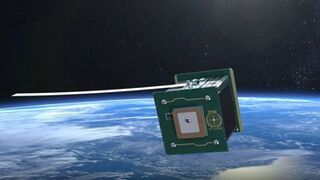
The TRSI-2 satellite is a real-world satellite orbiting earth, bearing the Star Citizen logo, launched on 2022-05-02 by ACME AtronOmatic, makers of the MyRadar app.
Star Citizen logo on the MyRadar satellite
ACME AtronOmatic was using other third-party data, which had its limitations for their purposes, along with a gap in the ability to provide some of the data. Meanwhile launch costs were coming down and ACME in-house technical capabilities were up to the challenge, so ACME decided to build and launch their own satellites, TRSI-1, TRSI-2 and TRSI-3.[1]
The early-stage purpose of the testbed satellites is to establish the workflow and proof of concepts, but both of them are still to be fully functional, with the intention to launch a constellation of satellites to allow more global coverage for both services each satellite was designed to address.[2]
As a way to pay tribute to Star Citizen and the inspiration it gave its CEO, just as science fiction such as Star Trek inspired him and others, ACME emblazoned the Star Citizen logo on the exterior of their testbed satellite TRSI-2.[1][3][4][5]
First satellite
TRSI-1 is also called MyRadar-1 and TRSI-Sat.
Second satellite, with the Star Citizen logo

The second satellite, TRSI-2, which is the one with the Star Citizen logo, is an introductory satellite intended as a testbed for the aviation side of ACME business, listening to aircraft tracking signals from space and transmitting them back down to the ground. Receiving the signals from space allows to track trans-oceanic aircraft away from ground stations and helps provide a redundant communication service to increase safety. Currently, MyRadar provides aircraft tracking services as well as arrival and departure delay information, gate information, and other flight details that can assist both the casual traveler and aircraft pilots/operators.[6][2]
The TRSI-2 satellite with the Star Citizen logo is a PocketQube launched on 2022-05-02 by the Rocket Labs "There and Back Again" mission with the Electron KS launch vehicle from the Mahia Launch Complex in New Zealand, with launch partner Alba Orbital.[7][8][9][10][2]
Third satellite
TRSI-3, the third satellite sent alongside the other two, is a weather/environmental observation testbed satellite, with the data getting back from the image processing helping with everything from hurricane predictions to agricultural analysis. Among others it can look inside the eye wall of a hurricane with a 3D stereoscopic imaging system called Hyperspectral Orbital Remote Imaging Spectrometer (HORIS), allowing to get greater details on the intensity and temperatures at the center of these storms and to provide for greater accuracy in tracking these storm.[7][2]
External Links
References
- ↑ 1.0 1.1 MyRadar & Star Citizen are going to Space!, MyRadar Weather News, YouTube, 22 nov. 2019
- ↑ 2.0 2.1 2.2 2.3 Exclusive – Star Citizen Goes to ACTUAL SPACE with MyRadar!, wccftech.com, Nov 22, 2019
- ↑ Vibration Qualification Testing of the TRSI Satellite, Paul Kocyla, YouTube, Jun 14 2019
- ↑ Integration of the TRSI satellite, Paul Kocyla, YouTube, Oct 4, 2019
- ↑ TRSI-2, nanosats.eu
- ↑ "Alba Orbital is pleased to announce our 5th customer on Alba Cluster 3 is a German/US 1p called ‘TRSI-2’ from MyRadar", Tom Walkinshaw, Linkedin
- ↑ 7.0 7.1 Alba X Cluster Launch, albaorbital.com,
- ↑ "The four pico-satellites in Alba Orbital’s cluster will fly as part of a rideshare mission on Rocket Lab’s Electron launch vehicle, lifting-off from Launch Complex 1 on New Zealand’s Mahia Peninsula in Q4, 2021.", Rocket Lab to Launch Four PocketQube Satellites for Alba Orbital, rocketlabusa.com,
- ↑ "Excited to announce our first customer has passed vibration qualification for Alba Cluster 2, flying on Rocketlabs electron later this year.", @AlbaOrbital, Twitter, Jun 12 2019
- ↑ TRSI-Sat (TRSI 1), TRSI 2, 3, space.skyrocket.de